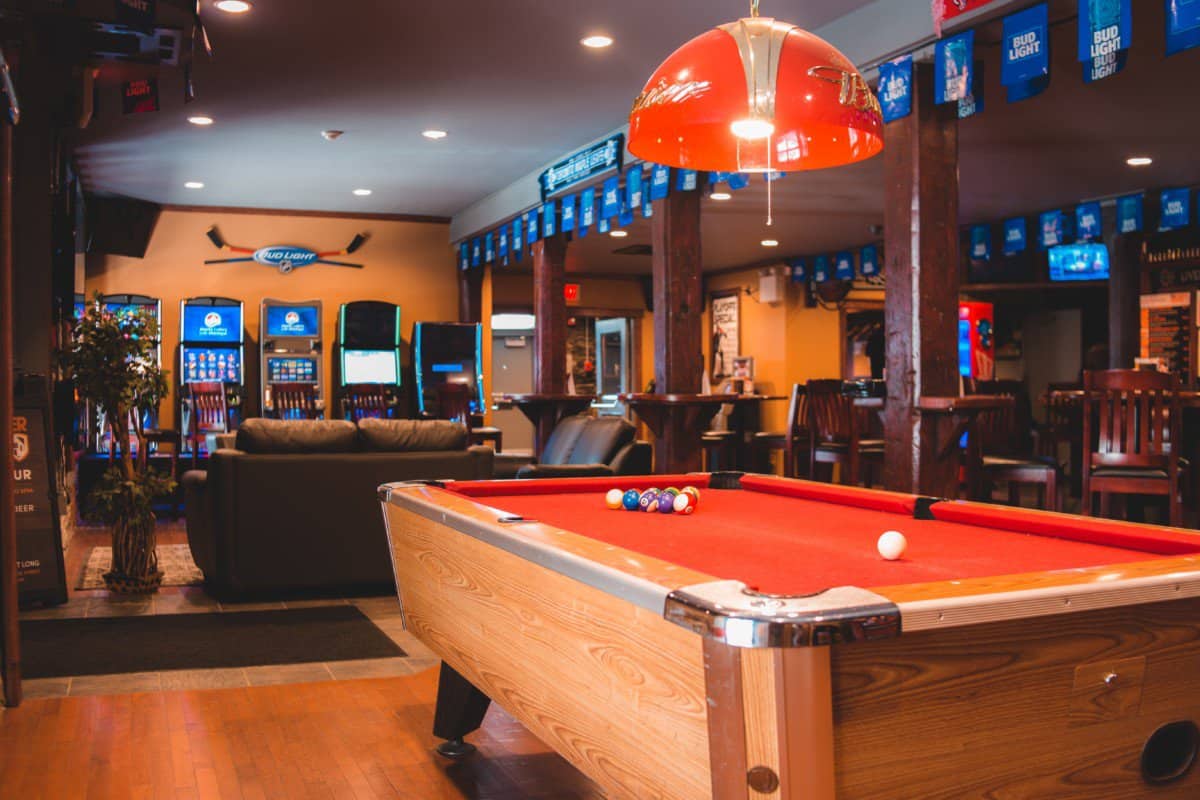A billiards table gives you the opportunity to have fun with friends, play solo to practice or meditate, win money, impress dates, and depending on how far you want to go win pool tournaments on tv! A unique game with many unspoken rules of etiquette, this article will keep you from stepping on toes out there.
What is Good Billiards/Pool Etiquette? Pool etiquette is showing respect to your opponent in pool by not being disruptive when their shooting and showing good sportsmanship throughout the match. An example would be not hovering near the pool table while your opponent is shooting.
Pool is certainly a good time, but you wouldn’t want to have embarrassingly bad pool etiquette like accidentally grabbing chalk while your opponent is shooting right?
So have some class, and let’s teach you the best pool etiquette you can find for free.
Good Pool Hall Etiquette
Now, I will teach you the top 11 pool etiquette rules that’ll either make you a hero with Matthew McConaughey level coolness, or a pool hall pariah. This is in order of importance, mostly, or at least lowest common denominator.
- Give your opponent their space and step away from the table. One of the biggest mistakes I see players make is grabbing chalk or hovering near a pool table. This is bad pool etiquette when it is your opponents turn. Just sit back in your chair and stand out of your opponents’ point of view. Any small thing can be distracting, and giving them their space with the table is a class act.
- Do not set your drinks on the table, period. Ever. Not only is it dumb, spilling your beer and nachos on the pool table is up there with puking in the hot tub or pooping your joggers in a Tough Mudder Race as one of the ultimate party fouls. Just don’t do it. The only thing worse is burning holes in the table by accident while smoking, which you really should quit anyway!
- No doing twirly spin moves with the pool cue. I know waiting your turn and being present is hard, but this game is for grown ups. Having swordfights, juggling the balls, showing people this fun game, you learned at camp where you launch the pool balls around by hand. Just stop. This is not flag team and we’re not 14 year olds. If you want to make up stupid games, spend your own hard earned cash on your own pool table and wreck that one. Very Very bad to do these things in public, or at all, for that matter.
- Don’t be distracting on purpose, or by accident- think tennis and golf sort of quiet. If you are playing with friends, fine, distract them, dance around, whatever douchebaggery you like. However, not only is this poor form, it is against the official pool association rules to stand behind an opponents shot. Besides, if they hit the ball wrong, you might be the new target! Be safe, and respectful, don’t stand in the direction they are aiming.
- NO JUMP SHOTS. This may be a guess, but 90% of all players aren’t advanced enough to attempt to jump the cue ball over another ball with any sort of pragmatism, and I would say even less can do it the proper way- it’s super awkward and you need to drive the cue ball into the table from above with enough force to make it jump back up. It’s easy to damage the table felt, mess up your cue tip, or launch a ball onto the floor if you don’t know what you’re doing. Also, it freaks people out if you screw up on their table! The only exception to this is if you are doing a correct jump shot where you shoot INTO the ball (not “Scooping” it where you shoot under the ball) and the pool hall allows it.
- Keep one foot on the ground, preferably both. Having at least one foot on the ground is a rule, but you can always tell someone is new if they lay across the table to reach. There’s a tool for reaching hard shots, it’s called a bridge. Use it! Even the pros do- sometimes.
- Keep what you would do to yourself. This is like pointing out a chess move when you’re not the one playing. We are not impressed with your mouthy genius. In a similar vein, as I mentioned before, it is against the rules and in poor form to coach anyone who is playing, unless they are your friend or significant other and you are giving more of a lesson. Offhand comments such as “well I would hit that one ball into the two ball towards the…” Or “why don’t you just block his pocket since you don’t have a good shot?” are irritating at best and may get you into real trouble.
- Shot calling, AKA playing on purpose. If you are playing with strangers, you will likely want to determine if you need to “call your shot”, meaning that if you are solids and aiming for your one ball (the yellow ball with a one on it), you say “one ball, middle pocket”. In this scenario, the one ball would be your target ball, and the middle pocket would be your intended pocket. Sink the ball, and your turn continues. If you sink your opponents ball, an unintended ball, or call the wrong pocket, your turn ends and your opponent may begin their turn. This is in the rule set, but when playing with strangers you can call “No slop” or ask “Do you like to call your shots or are we counting garbage?”
- Loser racks, winner breaks. Breaking is a privilege, and sets the tone for the game. You want a good break to have a good game. On a brand new game, the player who breaks is established by taking two balls, a stripe and a solid, and doing what is called lagging. After buying the game and retrieving the balls, each player spots their ball behind the headline, and shoots towards the foot line (where the dot usually is, if there’s no dot you can pretty much take your pick of directions to play, however a good rule of thumb is that the plaque that shows the brand of pool table is at the head spot, and you would break from that end. The object of the lag is to bounce your ball off the opposite cushion and return it as closely as possible to the head cushion without touching it, whoever’s ball is closer to the head cushion is the winner and the loser then racks the balls for the winner to break.
- Loser or challenger also buys the next game to get the table. Often, in more retro establishments, you will find that there are already quarters in the pool table ready to be pushed in for a new game. This is not random chance or your lucky day, this is common courtesy-though unfortunately less common than it used to be! If you find a pool table with quarters ready to go for you, it is your social responsibility as a good human being to leave quarters ready for the next player once you’re finished with the table. Especially if you are leaving it vacant. One of the few ways you can bring yourself some good karma in a pool hall!
- If you want to cut in on a table, and there’s only one, you can set a stack of quarters on the table indicating your place in line, but this is where it can get dicey (assuming you’re in a place where not everyone knows these things). This is like cutting in on a couple who are dancing. You will need to read the room, and the people playing. If you and your partner want to take the table from another player and their partner, to play a singles match, it is best to offer to play doubles, play for the table, versus the winner of the current match, or simply wait your turn by letting them know you’d like to play after them and still putting down quarters for the next game.
There may be a chalkboard or list somewhere too, so check with someone who works there. You can put down multiple stacks of quarters, but if you are the first players on the table and want to play more than one game it’s best to put down a few stacks. Say you’re doing best two out of three, and politely either give up the table or let the challenger buy a game against whichever of you the two of you that are currently playing win.
It is technically within your rights as a bar patron to set down a stack of quarters right off the bat, but if the players currently on the table haven’t heard of this piece of etiquette, you could start an argument by accident!
In Conclusion
The main thing to remember when playing with strangers is that a quick conversation at the beginning of the game to determine their level of seriousness will save you a lot of potential tension later on when it should’ve been avoided with a few questions.
If you don’t know how to play 8-Ball or want to know the different parts of a pool cue, here are some helpful articles I wrote on that.
Knowing the basic rules, what to call things, and then being aware of the above pool etiquette can help you out wherever you show up to play!
Related Questions
A lot of other common questions come up around pool. Here are some common questions we have seen and answered them below.
What is the Triangle thing called? The triangle is called the rack, and when putting balls in the rack you are “racking the balls”.
What do you call the White ball? The white ball is the “cue ball”
What do you call the colored balls? The colored balls are divided into “stripes” and “solids”. 1-7 is Solids, 9-15 is Stripes, and the 8-ball is just the 8-ball.
What do you call the pool stick? It’s called a Pool cue

